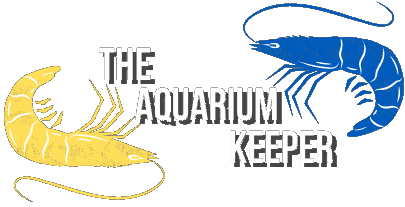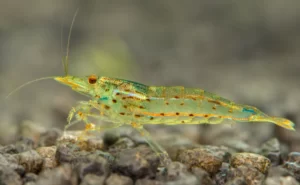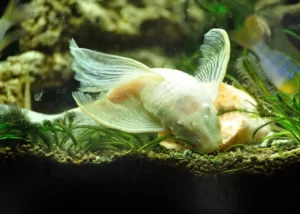
How to Choose the Best Substrate for Aquarium? Aquasoil, Sand & More

Writer at fitaquarium.com
Choosing the best substrate for your aquarium is an important decision that can affect the health and happiness of your aquatic species. The suitable substrate not only promotes healthy plant growth but also provides an adequate dwelling for your fish and invertebrates.
Determining which substrate is appropriate for your aquarium can be difficult given the variety of alternatives available.
This article will cover the criteria to take into account when selecting the best substrate for an aquarium, the many substrate kinds that are available, and how to set up and maintain your aquarium substrate.
Why is Substrate Important For Your Aquarium?
In order for aquatic plants and animals to thrive, the substrate is a crucial part of any fish tank. It provides a foundation for the growth of beneficial bacteria, which supports the nitrogen cycle, that keeps an aquarium healthy. The substrate also plays a crucial part in providing a natural environment for aquatic pets by mimicking the conditions present in their native habitat.
As substrate has an influence on the overall health and well-being of your aquatic pets, it is very important to select the one that meets their specific needs. Here are some important benefits of choosing the right substrate:
- Encourages healthy plant growth
- Supports beneficial bacterial growth
- Establishes a natural atmosphere
- Increases the aesthetic look
- Creates an appropriate habitat
- Maintains the quality of tank water
However, some aquarium species are not affected by the type of substrate you choose for them. For example, if you are caring for java Moss to grow, you don’t need to worry about the right substrate. It could attach literally to anything and can grow with little care.
Factors to Consider When Choosing The Substrate
It is important to carefully examine some of the following factors when selecting a substrate. I will go through these elements in more depth to assist you in choosing the best substrate for your aquarium. Choosing an aquarium substrate is not hard, it mainly depends on your setup and personal preference, but there are some things that you need to take into account.
Aquarium Fish And Plant Species
Firstly, your aquarium’s fish and plant species must be taken into account while choosing the appropriate substrate. Specific conditions must be met for different fish and plant species to thrive. For instance, most aquarium carpet plants need soil to flourish, yet bottom-dwelling fish like catfish and loaches need soft substrates that won’t damage their delicate barbels.
Size And Depth of Aquarium
These two aspects must be taken into account when choosing a substrate for your aquarium. A fine substrate, such as sand, is great for shallow aquariums since it provides a consistent distribution over the bottom of the tank. A bigger substrate, such as gravel, can be utilized in deeper aquariums because it offers a sturdy foundation for plants to root and thrive. The depth of the substrate should also be brought into consideration because various fish and plant species require different depths to flourish. Some plants just can’t root themselves properly in limited amounts of substrate.
Water Conditions
The proper substrate should be chosen while taking water characteristics like pH and water hardness into reference. Water chemistry may be impacted by certain substrates, changing the pH and hardness of the water. For instance, surfaces like broken coral and limestone can boost pH levels and increase water hardness, which is favorable for African cichlids but may not be appropriate for other species. To prevent any unwanted impacts on your aquatic pets, it is crucial to select a substrate that is suitable to your water’s specifications.
Best Substrates For Aquarium
There are many different substrate kinds on the market, each with special qualities and advantages. Some are cheaper and can be used literally anywhere, while other types of aquarium substrates are more expensive, and have their own purposes.
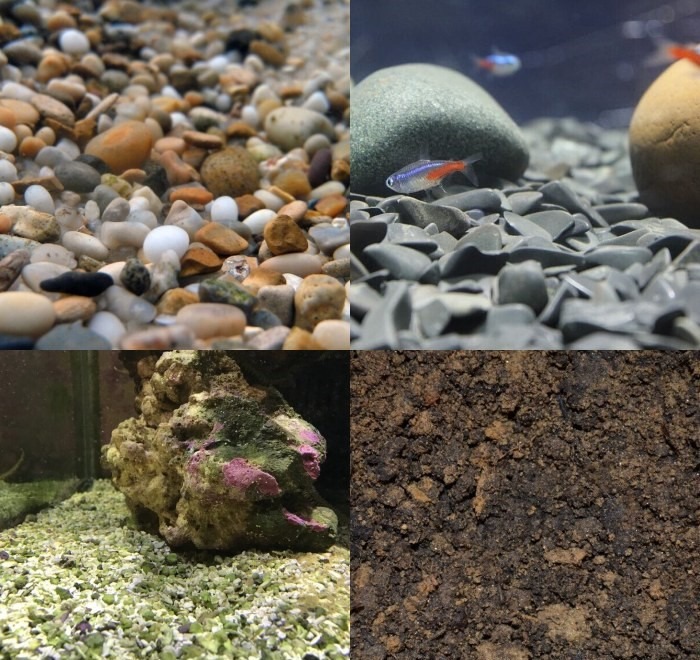
Gravel
Gravel is one of the most often used substrates in aquariums because it is inexpensive and is available in a wide range of colors and sizes.
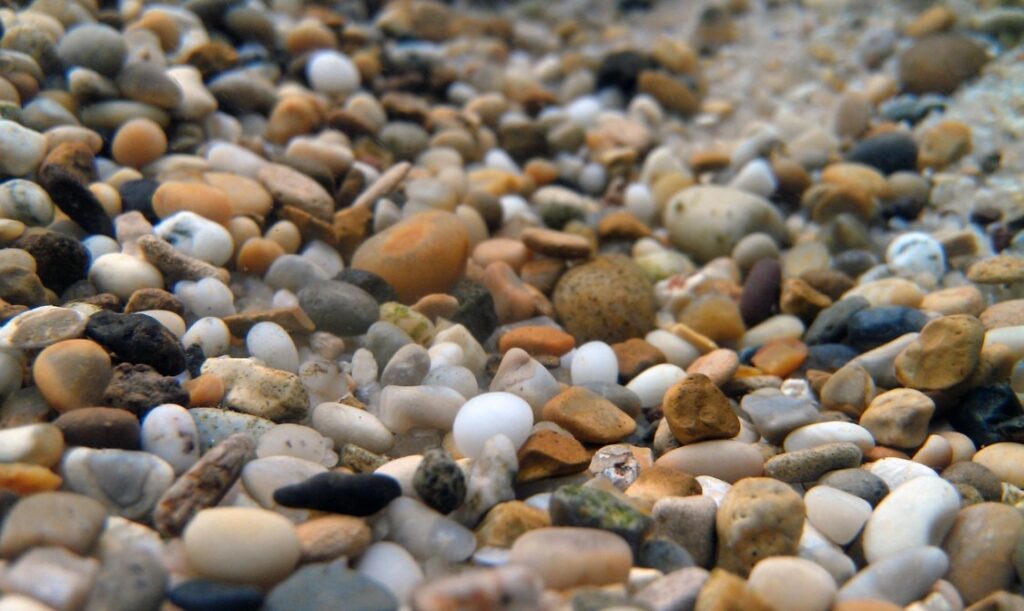
It enables for adequate water circulation and oxygenation as well as a strong foundation for plants to root and develop in. Cleaning may be difficult, too, since debris can become stuck in the gaps between gravel and become difficult to remove. Additionally, some types of gravel can change the chemistry of water by increasing water hardness and pH levels.
Gravel is best suited for fish that do not require specific water conditions, such as freshwater community tanks, goldfish, and cichlids, also plants, that do not primarily feed from roots, like column-feeding aquarium plants.
Sand
Sand is a popular substrate choice for aquariums due to its natural appearance and feel, and it could also offer fish who enjoy digging and sifting through the substrate with a cozy and exciting habitat.

Compared to gravel, it is also easy to clean since debris lies on top of the substrate rather than becoming wedged in between. However, just like gravel, some types of sand can affect water conditions like pH levels and water hardness. It also comes in a bunch of different colors, which means you can pick the right sand for your desired setup.
Sand is best suited for aquariums containing fish that need a soft and fine substrate, such as some cichlid, angelfish, and loach species. However, because the sand can easily be stirred up and cloud the water, it might not be appropriate for aquariums with high water flow rates. Additionally, since it can compact and prevent root growth, sand might not be the best material for planted aquariums.
Crushed Corals
Crushed Corals could also be considered while choosing a substrate for your Aquarium. Made from tiny bits of crushed corals, they can assist in raising the pH and alkalinity of the water in your aquarium.
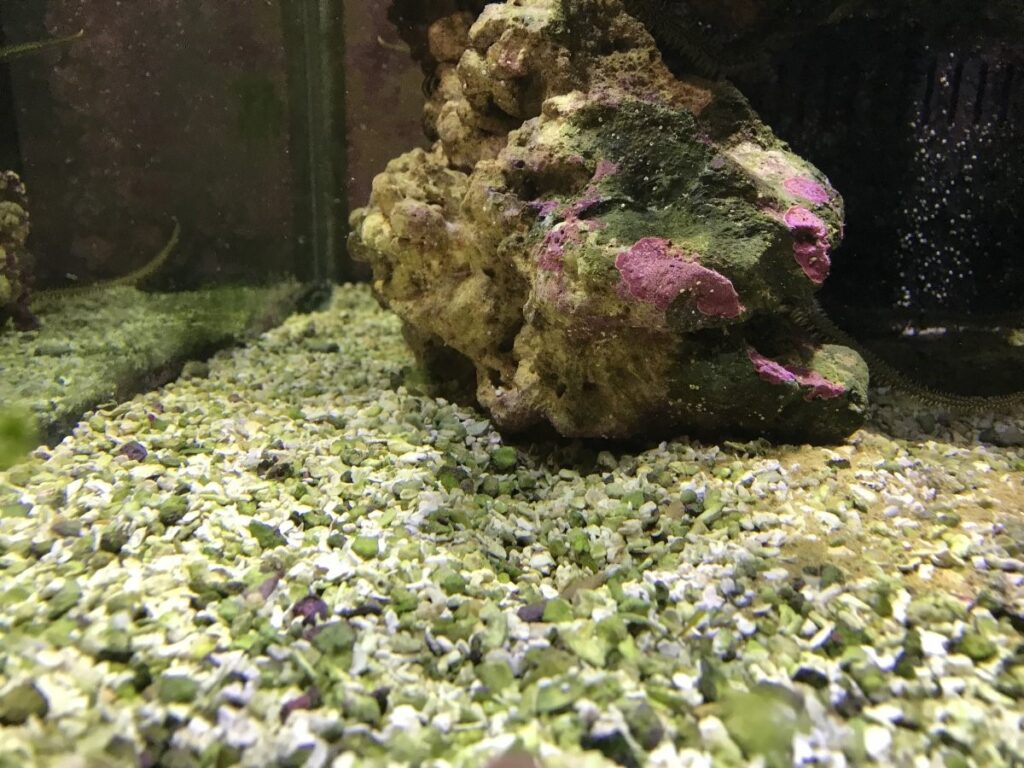
Crushed corals are an excellent option for aquariums housing particular fish species that demand a higher pH level, such as African cichlids. Because they serve as a source of calcium and magnesium, crushed corals are also beneficial for tanks with live plants. Although they can also increase the hardness of the water, they may not be the ideal option for aquariums that require softer water (for example, caridina shrimp need soft and acidic water to survive and crushed corals would be bad for these species).
As already mentioned, Corals increase pH and alkalinity levels in tank water, they are excellent choices for reef aquariums. They encourage the development of coralline algae which enhances the aquarium’s overall visual appeal.
Aquasoil
Aquasoil is a kind of substrate, composed of volcanic soil and has a porous structure, that assists in nutrient absorption and pH stability. It is often chosen by aquarists who wish to create a natural and colorful environment.
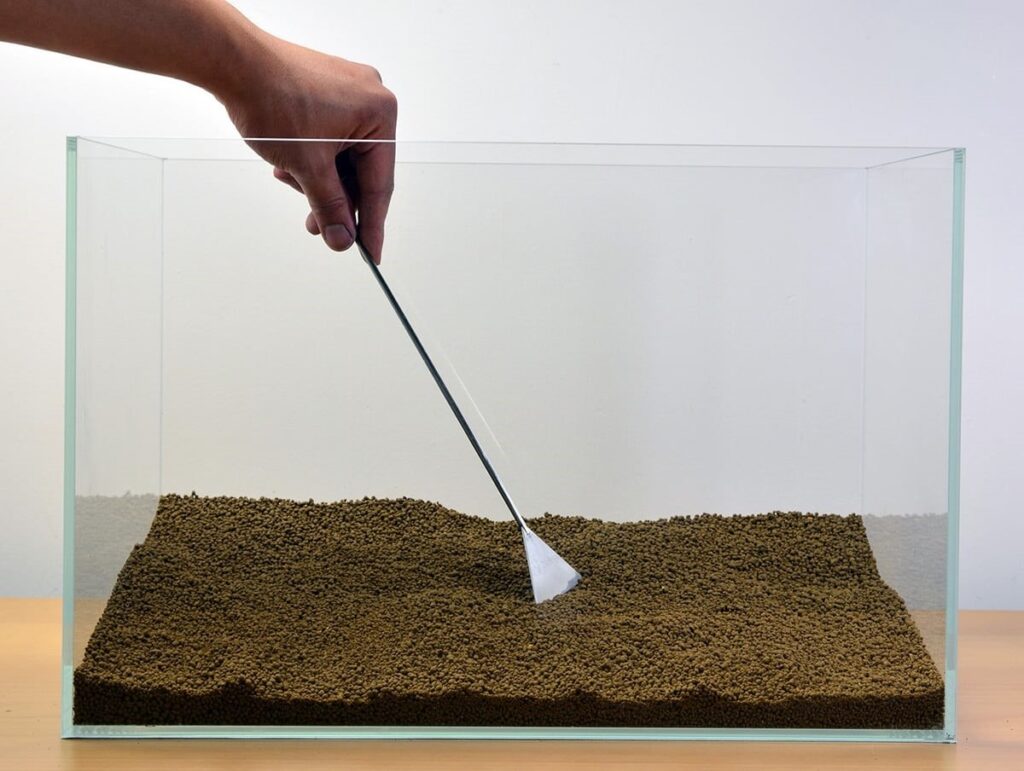
Additionally, aquasoil contains vital nutrients and minerals that support plant growth. It is not advised to use it in aquariums with high pH levels or with fish that prefer harder water. Although it is a great option for heavily planted tanks, you need to know, that after 1-2 years most of the nutrients from the soil are used by the plants, which means you would need to change the soil. Another small thing you should know is that aquasoil might first make the water cloudy and may need to be rinsed before use.
Aquasoil is best used for planted aquariums since it has been designed specifically to offer the best possible conditions for growing plants. Aquatic plants can grow and result in healthy roots because of the substrate’s abundant nutrients and minerals.
Dirt
Moving on, dirt is a less popular option as an aquarium substrate, but it still can be used successfully with some knowledge.

Dirt is an alternative to aquarium aquasoil, but it has its own strengths and weaknesses as a substrate. Firstly, using dirt as an aquarium substrate can cause your water to be muddy at first, and it takes more time to settle. Another thing is that you couldn’t keep fish, that like to stir up the substrate because dirt will just make your water not visible.
Although it is a more messy type of aquarium substrate, dirt is relatively cheap compared to aquasoil. Dirt also has a lot of nutrients, that can be absorbed by more demanding plants. If you are on a tight budget, dirt is a good option for heavily planted aquarium tanks. Just make sure to use the most basic dirt, that is used for flower planting and without any additives.
Pebbles, Shells and Stones
There are other varieties of substrates too, that may be utilized to improve the aesthetic of your aquarium.

For example, pebbles and river rocks may give your aquarium a more natural appearance and are frequently utilized in aquascaping. Similar to this, shells may be utilized to provide decoration to the substrate and benefit some fish species by raising the pH and hardness of the water.
Pebbles, shells, and stones are best suited as additional substrates that may give the aquarium a unique look and feel. Sand or dirt is frequently covered with pebbles as a top layer to keep them from shaking up. Shells are ideal for animals like snails and shell-dwelling cichlids because they may add calcium to the water and make it harder. For aquascaping, small stones may be utilized to create hiding places for fish and other aquatic creatures. Although it is crucial to check that these substrates don’t have any sharp edges or contain any chemicals that could endanger aquatic life.
Things to Know Before Adding Your Substrate to Aquarium
Moving on, a healthy and prosperous aquatic ecosystem is built on properly preparing and adding substrate in the tank. There are a couple of things that you should know before and while adding the best aquarium substrate to your tank.
Aquarium Substrate Cleaning
The substrate must be thoroughly cleaned and rinsed before being used in your aquarium. It is crucial to properly rinse the substrate with clean water before adding it to get rid of any dirt or dust that may have collected during transit and storage. By doing this, you can keep the water in your aquarium clear and of high quality. Additionally, it’s crucial to refrain from using any detergents or chemicals because they could endanger fish and other aquatic life.
Aquarium Substrate Handling
To prevent messing up the water and the ecosystem’s natural harmony, you should add substrate to your aquarium carefully. In order to achieve a depth that is suitable for the unique requirements of your fish and plants, it is vital to add the substrate to the aquarium’s bottom carefully and evenly. The substrate should not be too deep in planted aquariums since this might restrict root growth and result in unhealthy plants. After the substrate has been added, it is crucial to slowly and carefully add water to the aquarium, spreading the water with a plate or bowl to prevent disturbing the substrate.
Aquarium Substrate Maintenance
The waste and debris found in the substrate may build up and cause poor water quality, which can affect the health of your fish and plants. Therefore, it is essential to regularly vacuum and clean the substrate.
How to Vacuum Aquarium Substrate?
Regularly vacuuming the substrate maintains a healthy environment in your aquarium. Here is the step-by-step procedure to vacuum the substrate in an aquarium:
- Arrange an aquarium siphon and a bucket ( to contain the dirty water).
- Relocate any aquarium ornaments from the area you intend to vacuum.
- Aquarium siphons remove water and debris from your aquarium, using gravity.
- In my opinion, approximately one-third of the substrate should be vacuumed.
- After vacuuming is completed, get the siphon out of the tank.
- Fill the tank again with fresh clean water.
Please note, that sand is light enough to get sucked by the siphon, so pay extra attention while siphoning the sand substrate.
Vacuuming your tank substrate on a regular basis helps to avoid the accommodation of harmful wastes and debris, ensuring a healthy and thriving aquarium.
Frequently Asked Questions
Do Freshwater Fish Prefer Sand or Gravel?
Choosing between sand or gravel totally depends upon the kind of freshwater fish you have in your tank. Some freshwater fish species, including Cichlids and loaches, like sand substrate as it most nearly matches their native environment. On the other hand, gravel substrate may support a variety of different species just as well.
Which is The Best Substrate For Shrimp And Snails?
If you are setting up a tank for shrimps, then sand as a substrate would be a good option for you. Shrimps have delicate bodies and could be easily injured by rough surfaces like gravel. Some other options including fine-grained gravel or specialized substrates like aqua soil or shrimp substrate would also prove to be beneficial as they provide the necessary minerals for a healthy shell.
Writer's Thoughts
In short, it is essential to choose the proper substrate for your aquarium for the health and well-being of your aquatic animals and plants. Before selecting a substrate, think about your aquarium’s fish and plant species, tank size and depth, and water conditions. Once you’ve chosen and added it, Pay heed to maintain your substrate with regular cleaning and vacuuming. With a suitable substrate and regular care, you can make an attractive and healthy aquatic habitat for your fish and plants to thrive in.
If you enjoyed reading our article, please feel free to share it with your friends by clicking the social media buttons below:
About The Author
Josh is the owner and founder of fitaquarium.com – A blog that aims to help aquarium hobbyists with their queries about fish keeping. Josh enjoys sharing his expertise and insights with fellow hobbyists. Follow him on Instagram @fit_aquarium or reach out via email at josh@fitaquarium.com.
